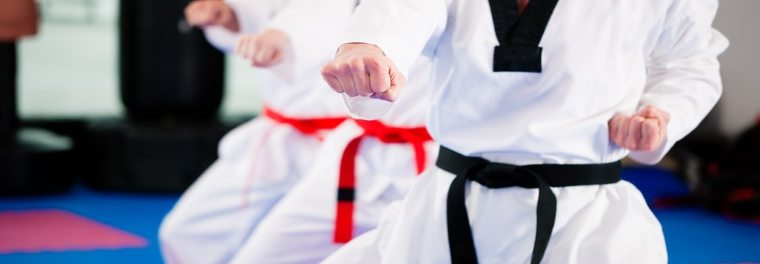I’m sure you’re wondering, “What do martial arts have in common with dog training?”
I suppose if this were a blog about protection dogs, the photo and title would be crafty little segues into the topic. Alas, this blog is about something less literal and more fundamental:
Trained behavior must travel with the student, no matter where she or he goes.
Learning something new in one place does not mean that same learning will be automatically applied in another. When I was a student of Escrima, a Filipino martial arts system, my Grand Master instructor would sometimes remind the class to refrain from “in-studio mentality.” He had observed in his years as an instructor that a highly trained martial artist can execute flawless technique and dominate when in the dojo, but can also “forget” everything once outside the classroom. Trained reactions can be slow to emerge, or fail to emerge completely, when in a setting other than the place where lessons were received. As an example, a student may quickly apply trained technique when grabbed by surprise in the classroom, but not so when in a parking lot. Behaviors can instantly revert to untrained reactions when confusion, distraction or nervousness enters the equation.
Also, our brains can formulate behavior based on location.
Sound absurd? It’s not uncommon for parents to experience bewilderment when their kids don’t say “thank you” when at a restaurant, but do it consistently when at home. It’s as if they never learned it, making the parents look bad (Ah, the joys of parenthood!) A common conclusion is that their children need more practice. A more complete conclusion would be that their children need more practice outside of the home environment so they are exposed to different cues.
Surroundings can strongly influence behavior, and this fact applies to dogs. What a dog learns in one location needs to be learned wherever else she is expected to exhibit the same response. If you typically ask your dog to Sit when in the kitchen, she’ll probably “forget how” if asked to Sit when in the bathroom. If you and your dog have only practiced the Leave It cue when treats are on the carpet, she’ll likely “forget how” while outside on a walk. If you regularly train with your dog, remember to vary the time of day. You’ll also want to stop wearing a treat pouch, saying the same old thing (“Ready to work?”), or practicing behaviors in the same order. Dogs learn through association, and all of these things say, “It’s time to train.” This also means that in their absence, these things say, “Training is over. You don’t have to do this stuff until it’s time to train again.”
Humans can also learn through association, and a parallel can be drawn to my Escrima instructor’s warning about in-studio mentality. The martial arts student was told, “It’s time to train” when she put on her uniform, packed her bag full of training weapons, and walked into the dojo. After an hour, she was told, “You won’t have to do this stuff until the next lesson” when she re-packed her training gear, changed out of her uniform and stepped out of the dojo. Expect to have to re-train behaviors in new places and in different circumstances.
It is not a bad reflection on you or your dog.
Also, the good news is that it won’t take long for your dog to re-learn it. She’ll come to understand that the desired behavior depends on the cue you give; not on where she is at the time.
Go beyond “in-studio training.” Teach your dog to trust your cues outside of the home.
Want Us to Fetch Doggy Bloggies For You?
Enter your email address to subscribe. You won’t get any spam, unless it’s a blog about a dog eating it.

